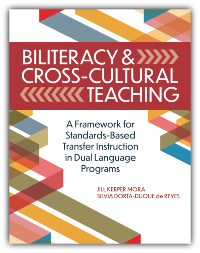 If you’re an educator working in a Spanish/English dual language program, today’s post is for you. Excerpted and adapted from the upcoming book Biliteracy and Cross-Cultural Teaching by Jill Kerper Mora & Silvia Dorta-Duque de Reyes, this article explains why a focus on teaching for transfer is so important, and how it empowers teachers to identify and investigate issues that arise in teaching students in multilingual contexts.
If you’re an educator working in a Spanish/English dual language program, today’s post is for you. Excerpted and adapted from the upcoming book Biliteracy and Cross-Cultural Teaching by Jill Kerper Mora & Silvia Dorta-Duque de Reyes, this article explains why a focus on teaching for transfer is so important, and how it empowers teachers to identify and investigate issues that arise in teaching students in multilingual contexts.
What is Transfer?
Transfer of learning is the application of skills, knowledge, and/or processes already learned in one context to another learning situation. For example, a child who learns how to roller skate during the summer may be able to transfer his roller-skating skills to learning how to ice skate in the winter. Transfer is both an interactive process and an outcome when the learner discovers similarities between the known and the new. As the experienced roller skater learns to balance on a single blade rather than four wheels, certain changes in behavior must be made to adapt to the new learning situation. Therefore, teaching for transfer involves supporting students to build on skills that they have already acquired, which is part of the process of learning how to learn.
In a multilingual context, transfer is the dynamic process in which the learner applies their repertoire of linguistic and cultural knowledge in learning to communicate and interact through a new or second language. Dual language teachers build instructional environments that facilitate transfer from one situation to another, because all learning depends on some connection to past learning.
Learning environments where two languages of instruction are involved require attention to similarities between learning tasks and context. For instance, a first-grade teacher conducts Morning Routine in Spanish or English on alternate days. The similarity of the vocabulary for the routine prompts students to become aware of the commonalities and differences between oral and written forms in the two languages.
Detect-Elect-Connect
General transfer of learning theory proposes phases of awareness and conscious learning of knowledge and skills. For example, Perkins and Salomon (2012) propose that transfer of learning requires three steps: detect-elect-connect.
- First, the learner detects the relationship between a previously learned concept or idea and a new concept.
- Next, the learner elects to consciously pursue the relationship or principle to make it available for understanding in a novel situation. This elective mental activity represents the motivational element in transfer of learning.
- Then, the learner makes the connection between the initial learning and the new learning situation.
In the Morning Routine example, a first grader, Carlos, sees the teacher Ms. Molino write “Hoy es martes.” Carlos thinks that she has made a mistake because in English, the day of the week is written with a capital T and states: “Martes needs a capital letter M.” Carlos has detected a difference between the Spanish and the English spelling convention. Ms. Molino explains that in Spanish, days of the week are not capitalized. Then Carlos erases the capital M on “martes” to spell the word correctly in his journal. He elects to apply his new knowledge to the novel situation of writing in Spanish. Ms. Molino encourages metalinguistic reflection by having students make a connection between the rules for spelling the names of days of the week in Spanish and English in their journal. This type of contrastive observation to bring transferable and non-transferable concepts to students’ higher levels of awareness are at the core of transfer instruction in multilingual classrooms.
Goals of Teaching for Transfer
The goal of teaching for transfer is to create conditions where multilingual students utilize their full linguistic repertoire for language, literacy, and content learning through tasks in two languages. A teaching for transfer paradigm for program design and classroom instruction counteracts misguided notions about a need to “teach twice” in both languages to ensure student learning. Rather, the academic goal of teaching for transfer is to build students’ awareness of similarities and contrasts between the languages as a basis for cross-linguistic transfer. This is termed “metalinguistic awareness.”
In the scenario above, where Carlos detects the difference between English and Spanish capitalization rules for days of the week during Ms. Molino’s Morning Routine, Carlos soon discovers another contrast when he attempts to translate the sentence “La fiesta es el martes.” At first, he writes “The party is the Tuesday.” This doesn’t sound right to him, so he asks the teacher for help. She explains that Spanish uses “el” to specify a day of the week when an event will take place, while English uses “on.” She asks Carlos, “So how would you say, “The party is on Sunday” in Spanish?” “He answers correctly, “La fiesta es el domingo.” Carlos has just learned an important grammatical contrast between the use of the definite article and the use of a preposition in Spanish and English. Although Carlos may make this error again, his awareness of the contrastive usages is now established.
Teaching for transfer also serves sociocultural goals for achieving equitable multilingualism as teachers attend to the social and cultural forces that influence feelings, attitudes, values, thoughts, beliefs, interactions, and behaviors that are typical of different cultures. Simultaneously, students develop a bilingual and bicultural identity as they interact with each other across the cultures represented in the classroom. As students grow in self-awareness, their identity shifts from that of a monolingual/cultural persona to a bi/multilingual/multicultural persona and eventually a global citizen persona (Crozet, 2015). Crozet describes this process as beginning with the idea “I am my language/culture” to I am my two (+) languages/cultures” to “I am not my languages/cultures. I use them to interact with others and the world.”
Teaching for transfer can unlock the full potential of bilingual education. For a complete practical guide to cross-cultural teaching, order the book behind today’s post (it’s scheduled for release in April 2025).

Biliteracy and Cross-Cultural Teaching
A Framework for Standards-Based Transfer Instruction in Dual Language Programs
By Jill Kerper Mora, Ed.D., & Silvia Dorta-Duque de Reyes, M.A.Ed.
With this comprehensive guide on curriculum design for biliteracy instruction and cross-cultural teaching, you’ll discover an effective model for creating inclusive, dynamic, and effective multilingual and multicultural learning environments.
Stay up to date on the latest posts, news, strategies, and more!
Sign up for one of our FREE newslettersTopics
Tags
More posts like this

10 Quotes on Teaching Multilingual Learners
August 19, 2025
9 Schoolwide Changes That Support Literacy Development for Multilingual Learners
November 16, 2023


Write a Comment
Your email address will not be published. Required fields are marked *
Post a Comment